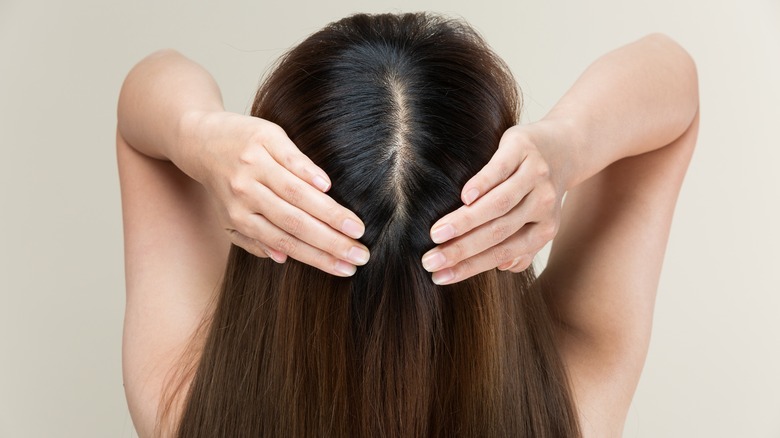How To Differentiate Between Breakage And New Growth Hair
Hair breakage and loss can be caused by a myriad of factors — changes in diet, heat damage, and even excessive washing — but shedding a bit of hair is a natural process that occurs over time (via Healthline). Even if you're dedicated to avoiding harsh treatments or damaging hair ties, you'll probably experience a few fallen or broken strands each day. As a result, you'll come into contact with the enemy of the classic sleek ponytail: flyaways.
Flyaways, those shorter pieces of hair that inevitably stick straight up on a humid day, are often assumed to be the result of damage. In some cases, this is true. As damaged hair splits up the shaft, you may be left with breakage and shorter strands as a result. On the other hand, however, these flyaways can also be a sign of thicker, healthier hair to come. New growth doesn't instantly reach the length of the rest of your mane, so fresh strands of hair could look deceptively like damage until they fully grow out.
Feel the shorter hair's texture
If you want to determine if your flyaways are the result of damage or new growth, the first step is to find a few to identify. The easiest way to do this is by pulling your hair into a low ponytail and letting the shorter pieces stick out from the root so you can get a closer look. Take a look in the mirror in a well-lit bathroom, and begin by gently feeling the texture of a few of the strands.
If you've ever dealt with bleach or heat damage, you likely know what a damaged strand of hair feels like. They're typically more coarse and dry to the touch, and you could even feel a few lumps and bumps from internal splits. New hair growth, however, should match with the rest of the texture of your hair and feel smooth throughout. If you're still having difficulty differentiating, however, take a look at the shape of the ends for some more obvious signs.
Take a look at the ends
New hair growth and breakage might look similar from afar, but if you take a look at the very end of the hair shaft, there's an easy way to see what kind of flyaways you're dealing with. Breakage can be the result of hair that's been ripped from aggressive styling or splits traveling up the hair shaft, whereas new growth is just coming straight from the root and catching up with the rest of your hair.
Because of this, breakage will have either a blunt, flat edge, or telltale splits that could mean the damage is continuing even further up. The ends could also include a small dot that appears lighter than the rest of your hair as evidence of a previous break. New growth, on the other hand, should be the same color as the rest of your hair and taper off at the very end, eventually ending in a subtle point.
Notice where flyways are gathered around your head
Another telltale sign that you're dealing with breakage has to do with the location of flyaways on your head. Take a look at the pieces that popped out of the ponytail, and note where they are concentrated. If it's all in one area, especially towards the crown of your head, its likely the result of breakage, especially from consistently wearing a too-tight ponytail or using a damaging hair tie (via Carol's Daughter).
If the pieces are scattered throughout your head and are of similar lengths, coupled with an overall smooth texture and tapered ends, you can rest assured those are new strands that are springing up to fill the spaces of other lost hairs. Either way, flyaways can be a bit annoying, but they're a natural part of the hair's growth process. With a bit of TLC and protection, you'll be able to guarantee that these stray strands grow out to leave you with a lush, healthy head of hair, while damaged pieces are stopped from breaking off any shorter.



